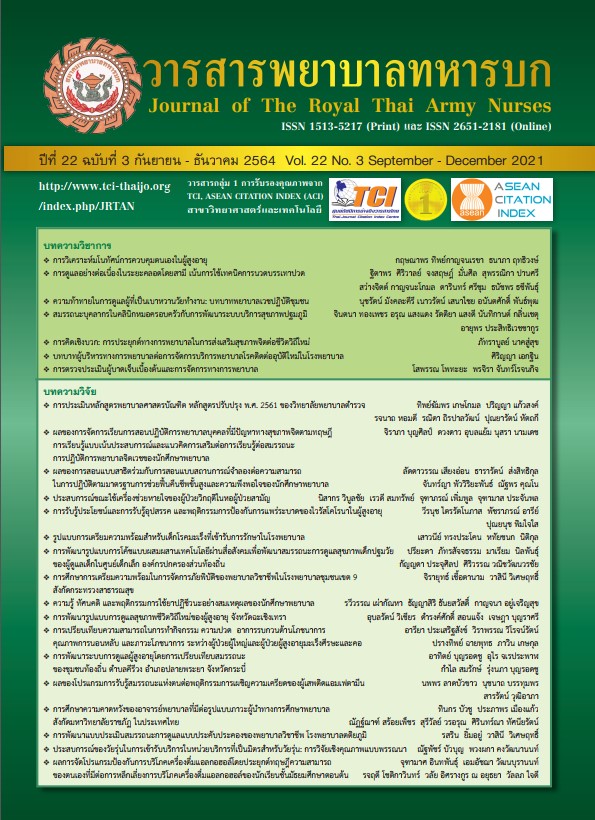Continuous Labour Support by the Husband or Partner, focusing on Massage Techniques for Pain Relief
Keywords:
continuous labour support, husband or partner support, massage techniques for pain reliefAbstract
Childbirth is a major event of a women’s life in which they have to deal with labour pain inside unfamiliar environment and people. Women giving birth in most public hospitals in Thailand are not allowed to have family members or husbands attending during labour, leaving women facing the scary and uncomfortable situation by themselves. Continuous labour support has played a pivotal role in determining positive or negative childbirth experiences and outcomes. Ample evidence has shown the advantages of continuous labour support on labour pain, duration of labour, analgesic use, cesarean section rate, and women’s satisfaction, especially when support is provided by family members or husbands. Although conventional labour cares are provided by midwives, a shortage of midwives has led to a dissatisfaction and negative experiences amongst women giving birth. Labour pain management seems to use more pharmacological methods leading to unfavorable side effects on mothers and newborns. Non-pharmacological pain management such a massage technique which is uncomplicated for training, has been underpinned by extensive evidence demonstrating the effectiveness on labour pain relief. Therefore, the combination of continuous labour support by husbands, who are trained to support labouring women focusing on massage techniques, would optimize the quality of maternity care and maternal and neonatal outcomes. This article aims to describe the benefits of continuous labour support by husbands or partners during childbirth, focusing on massage techniques with the realistic plan for a proposed change strategy to apply and embed the practice within maternity settings of public hospitals in Thailand.
Downloads
References
Chunuan S, Kala S, Kochapakdee W. Childbirth policy in Thailand: is it a time to change?. Songklanagarind Medical Journal. 2004; 22(4):263-72.
Lundgren I. Swedish women’s experience of childbirth 2 years after birth. Midwifery. 2005;21(4):346–54.
Bell AF, Andersson E. The birth experience and women’s postnatal depression: A systematicreview. Midwifery. 2016;39:112-23.
Nilsson C, Lundgren I, Karlström A, Hildingsson I. Self reported fear of childbirth and its association with women’s birth experience and mode of delivery: A longitudinal population-based study. Women and Birth. 2012;25(3):114–21.
Yuenyong S, Jirapaet V, O’Brien BA. Support from a close female relative in labour: The ideal maternity nursing intervention in Thailand. J Med Assoc Thailand. 2008;91(2):253–60.
Sinlatamkij C, Piriya S. Effects of Labor Support Program on Pain-Coping Behavior and Childbirth Experience among Primiparous Women Who Received Oxytocin. 2019; 20(April):216–25.
Bohren MA, Hofmeyr GJ, Sakala C, Fukuzawa RK, Cuthbert A. Continuous support for women during childbirth. Cochrane Database of Systematic Reviews. 2017(7).
World Health Organization. WHO recommendation on companionship during labour and childbirth. The WHO Reproductive Health Library. 2018;(February):1–11.
Ballen LE, Fulcher AJ. Nurses and doulas: Complementary roles to provide optimal maternity care. JOGNN - J Obstet Gynecol Neonatal Nurs. 2006;35(2):304–11.
Hodnett ED, Gates S, Hofmeyr GJ, Sakala C. Continuous support for women during childbirth. Cochrane database of systematic reviews. 2013(7).
Walker DS, Visger JM, Rossie D. Contemporary childbirth education models. Journal of midwifery & women’s health. 2009 Nov 1;54(6): 469-76.
Yargawa J, Leonardi-Bee J. Male involvement and maternal health outcomes: Systematic review and meta-analysis. J Epidemiol Community Health. 2015;69(6):604–12.
Romano AM, Lothian JA. Promoting, protecting, and supporting normal birth: A look at the evidence. Journal of Obstetric, Gynecologic & Neonatal Nursing. 2008;37(1):94-105.
Jungari S, Paswan B. Where Is the Husband?. Economic & Political Weekly. 2017;52(39):19.
Chunuan S. Patient satisfaction with health care services received during intrapartum in one regional hospital in the southern part of Thailand [dissertation]. Kentucky: University of Kentucky; 2002.
Konchaiw N, Nirattharadorn M, Buaboon N, Sanguanklin N. Effects of a self-efficacy promotion program and husband participation on the repeated pregnancy prevention behaviors among adolescent mothers. Journal of The Royal Thai Army Nurses. 2018;19:326-35. (in Thai)
Sapkota S, Kobayashi T, Takase M. Impact on perceived postnatal support, maternal anxiety and symptoms of depression in new mothers in Nepal when their husbands provide continuous support during labour. Midwifery. 2013;29(11):1264–71.
National Collaborating Centre for Women’s and Children’s Health (UK). Intrapartum Care: Care of healthy women and their babies during childbirth. NICE Clinical Guideline No 190. London: National Institute for Health and Care Excellence (UK); 2014.
Hu Y, Lu H, Huang J, Zang Y. Efficacy and safety of non-pharmacological interventions for labour pain management: A systematic review and Bayesian network meta-analysis. Journal of Clinical Nursing. 2021;(May):1–17.
Melzack R, Wall PD. Pain mechanisms: a new theory. Science. 1965;150(3699):971-9. 21. Field T. Pregnancy and labor massage. Expert review of obstetrics & gynecology. 2010;5(2): 177-81.
Field T, Hemandez-Reif M, Taylor S, Quintino O, Burman I. Labor pain is reduced by massage therapy. Journal of Psychosomatic Obstetrics & Gynecology. 1997;18(4):286-91.
Silva Gallo RB, Santana LS, Jorge Ferreira CH, Marcolin AC, PoliNeto OB, Duarte G, et al. Massage reduced severity of pain during labour: A randomised trial. Journal of Physiotherapy. 2013;59(2):109–16.
Chaillet N, Belaid L, Crochetière C, Roy L, Gagné GP, Moutquin JM, et al. Nonpharmacologic approaches for pain management during labor compared with usual care: A meta-analysis. Birth. 2014;41(2):122–37.
Cummings S, Bridgman T, Brown KG. Unfreezing change as three steps: Rethinking Kurt Lewin’s legacy for change management. Hum Relations. 2016;69(1):33–60.
Hartrick CT, Kovan JP, Shapiro S. The Numeric Rating Scale for Clinical Pain Measurement: A Ratio Measure?. Pain Practice. 2003;3(4): 310-6.
Poonperm R., Proyngern J., Sunanta S., & Prompeng N. Effectiveness of Question Based Learning of nursing students at The Royal Thai Army Nurses, 2018;19(3):126-136, (in Thai)
Eaksamai S., Arayatanitkul B., Sripako P., & Lamtrakul S. A Systematic Review and Meta-analysis Does Kangaroo Mother Care (KMC) Reduce The Duration of Phototherapy in Infants with Jaundece. 2019;20(3): 8-17 (in Thai)
Downloads
Published
How to Cite
Issue
Section
License
บทความหรือข้อคิดเห็นใดใดที่ปรากฏในวารสารพยาบาลทหารบกเป็นวรรณกรรมของผู้เขียน ซึ่งบรรณาธิการหรือสมาคมพยาบาลทหารบก ไม่จำเป็นต้องเห็นด้วย
บทความที่ได้รับการตีพิมพ์เป็นลิขสิทธิ์ของวารสารพยาบาลทหารบก
The ideas and opinions expressed in the Journal of The Royal Thai Army Nurses are those of the authors and not necessarily those
of the editor or Royal Thai Army Nurses Association.






